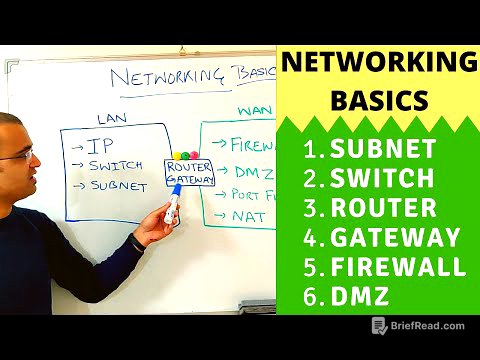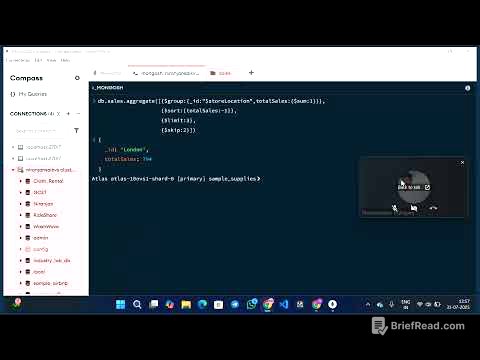TLDR;
This video provides a comprehensive one-shot MCQ class on matrices and determinants for HSC exams. It covers basic matrix types, including row, column, rectangular, square, diagonal, scalar, unit, upper triangular, and lower triangular matrices. The lecture also discusses concepts like symmetric, skew-symmetric, orthogonal, involutory, and idempotent matrices, along with matrix operations such as addition, subtraction, and multiplication. The video explains how to find the trace of a matrix, adjoint of a complex matrix, and inverse of a matrix, including properties and shortcuts for solving MCQs efficiently.
- Covers basic matrix types and their properties.
- Explains matrix operations and related theorems.
- Provides shortcuts for solving MCQs on determinants and inverse matrices.
- Includes practice questions and homework for self-assessment.
Introduction to Matrices and Determinants [0:00]
The session starts by welcoming students to a one-shot MCQ class focusing on matrices and determinants, essential for the HSC exam. The instructor assures that by mastering the concepts discussed in class and practicing the provided questions, students can confidently tackle any MCQ from this chapter. The goal is to ensure students can accurately and efficiently solve matrix and determinant problems in their HSC exams.
Basic Matrix Types: Row, Column, and Rectangular Matrices [0:23]
The lecture begins with a discussion of basic matrix types. A row matrix is defined as a matrix with only one row, while a column matrix has only one column. A rectangular matrix is one where the number of rows is not equal to the number of columns, denoted as m x n where m ≠ n. Examples are provided to illustrate these definitions, such as a 3x4 rectangular matrix and a row matrix with multiple columns.
Square and Diagonal Matrices [1:14]
A square matrix is defined as a matrix where the number of rows equals the number of columns (m = n). The discussion transitions to diagonal matrices, which are square matrices where all elements outside the main diagonal are zero. The main diagonal is the diagonal running from the top-left to the bottom-right corner. The entries on the main diagonal can be any value, but all other entries must be zero.
Understanding Diagonal Matrix Entries [3:37]
The explanation clarifies that for a matrix to be a diagonal matrix, it must first be a square matrix. The entries along the main diagonal can be any value, but all entries above and below the main diagonal must be zero. The entries of a matrix are denoted as aᵢⱼ, where 'i' is the row number and 'j' is the column number. For diagonal matrices, aᵢⱼ = 0 when i ≠ j.
Scalar Matrices: A Special Case of Diagonal Matrices [9:36]
A scalar matrix is introduced as a special type of diagonal matrix where all the elements on the main diagonal are the same. This means that in addition to being a square matrix with non-diagonal elements equal to zero, the diagonal elements must all have an equal value. Examples include a matrix with all diagonal entries being 3 or all being -2.
Unit or Identity Matrices [10:39]
A unit matrix, also known as an identity matrix, is a scalar matrix where all the diagonal elements are equal to one. It is denoted by 'I'. The unit matrix serves as the multiplicative identity in matrix algebra, meaning that for any matrix A, AI = IA = A.
Triangular Matrices: Upper and Lower [11:38]
The lecture introduces upper triangular matrices, which are square matrices where all entries below the main diagonal are zero. Conversely, lower triangular matrices are square matrices where all entries above the main diagonal are zero. The terms "upper" and "lower" refer to the triangular shape formed by the non-zero entries.
Idempotent and Involutory Matrices [15:10]
An idempotent matrix is defined as a matrix that, when squared, results in the same matrix (A² = A). An involutory matrix is one that, when squared, results in the identity matrix (A² = I). These definitions are crucial for identifying these types of matrices in MCQ questions.
Transpose of a Matrix [16:10]
The transpose of a matrix is obtained by interchanging its rows and columns. If A is an m x n matrix, its transpose, denoted as Aᵀ or A', is an n x m matrix. The first row of A becomes the first column of Aᵀ, the second row becomes the second column, and so on.
Symmetric Matrices [17:18]
A symmetric matrix is a square matrix that is equal to its transpose (A = Aᵀ). This means that the elements are symmetrically distributed about the main diagonal. For a symmetric matrix, aᵢⱼ = aⱼᵢ for all i and j.
Skew-Symmetric Matrices [21:17]
A skew-symmetric matrix (also called antisymmetric) is a square matrix whose transpose is equal to its negative (Aᵀ = -A). In a skew-symmetric matrix, the diagonal elements are always zero, and aᵢⱼ = -aⱼᵢ for all i and j.
MCQ Practice: Identifying Matrix Types [25:36]
The session transitions to solving MCQs to reinforce the concepts learned. The first question asks to identify an involutory matrix. The key is to recognize that an involutory matrix, when squared, equals the identity matrix. The lecture emphasizes that to square a matrix, it must be a square matrix.
MCQ on Idempotent Matrices [27:15]
Another MCQ asks to identify an idempotent matrix. An idempotent matrix, when squared, equals the original matrix. The lecture reiterates that the matrix must be a square matrix to be idempotent.
MCQ on Diagonal Matrices [28:14]
An MCQ focuses on the conditions for a diagonal matrix. The correct answer emphasizes that while all non-diagonal entries must be zero, there are no specific conditions for the entries on the main diagonal.
MCQ on Symmetric Matrices [30:13]
The lecture presents an MCQ to identify a symmetric matrix. The key is to remember that in a symmetric matrix, aᵢⱼ = aⱼᵢ. The lecture also points out that the diagonal entries can be any value.
MCQ on Skew-Symmetric Matrices [31:28]
An MCQ focuses on identifying a skew-symmetric matrix. The lecture emphasizes that in a skew-symmetric matrix, aᵢⱼ = -aⱼᵢ and the diagonal elements are zero.
MCQ on Matrix Addition and Subtraction [45:42]
The lecture moves to MCQs involving matrix addition and subtraction. The key point is that matrices can only be added or subtracted if they have the same dimensions. The corresponding entries are then added or subtracted.
MCQ on Matrix Multiplication Conditions [53:32]
The lecture discusses the conditions for matrix multiplication. If A is an m x n matrix and B is an n x p matrix, then the product AB is an m x p matrix. The number of columns in the first matrix must equal the number of rows in the second matrix.
MCQ on Matrix Dimensions After Multiplication [56:09]
An MCQ focuses on determining the dimensions of the resulting matrix after multiplication. The lecture reiterates that if A is an m x n matrix and B is an n x p matrix, then the product AB is an m x p matrix.
MCQ on Transpose and Matrix Operations [59:05]
The lecture presents an MCQ involving the transpose of matrices and matrix operations. The key is to remember that the transpose of a sum is the sum of the transposes: (A + B)ᵀ = Aᵀ + Bᵀ.
Trace of a Matrix: Definition and MCQs [35:58]
The trace of a matrix is defined as the sum of the elements on its main diagonal. The matrix must be a square matrix for the trace to be defined. An MCQ is presented to calculate the trace of a given matrix.
Complex Matrices and Adjoint [36:55]
A complex matrix is a matrix that contains complex numbers as its elements. The adjoint of a complex matrix is found by taking the conjugate of each element. The conjugate of a complex number a + ib is a - ib.
Properties of Matrix Operations: Inverse and Transpose [1:26:21]
The lecture discusses important properties of matrix operations, including the inverse and transpose. Key properties include: (AB)⁻¹ = B⁻¹A⁻¹ and (Aᵀ)⁻¹ = (A⁻¹)ᵀ.
Determinants: Properties and Shortcuts [1:35:23]
The lecture covers properties of determinants, such as: If two rows or columns of a determinant are identical, the value of the determinant is zero. Also, if a row or column is multiplied by a scalar, the determinant is multiplied by that scalar.
Shortcuts for Determinant Calculations [1:46:34]
The lecture introduces shortcuts for calculating determinants, particularly for specific matrix structures. One shortcut involves recognizing patterns in the matrix that allow for quick calculation of the determinant.
Cofactors and Minors [1:51:32]
The lecture explains how to find the cofactor of an element in a matrix. The cofactor is the minor (determinant of the submatrix formed by deleting the row and column of the element) multiplied by (-1)^(i+j), where i and j are the row and column indices of the element.
Condition for Non-Invertibility [1:59:26]
The lecture concludes by discussing the condition for a matrix to be non-invertible. A matrix is non-invertible (singular) if its determinant is zero. This is because the inverse of a matrix involves dividing by its determinant, which is undefined when the determinant is zero.









